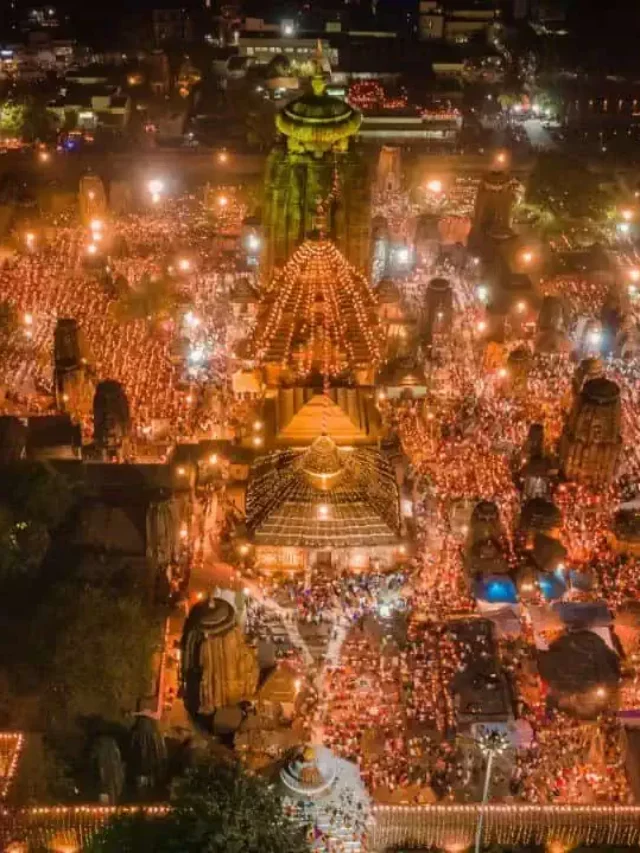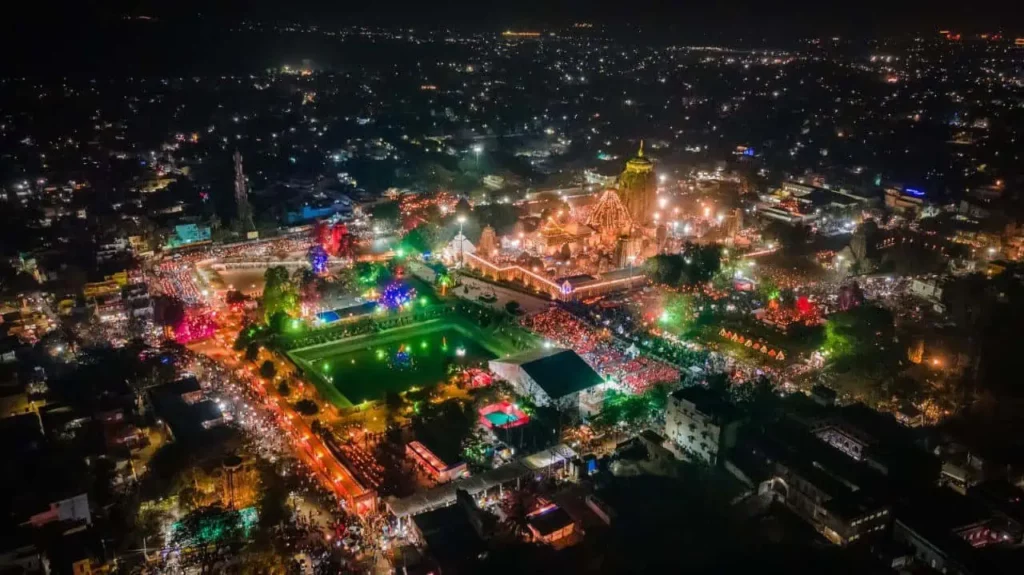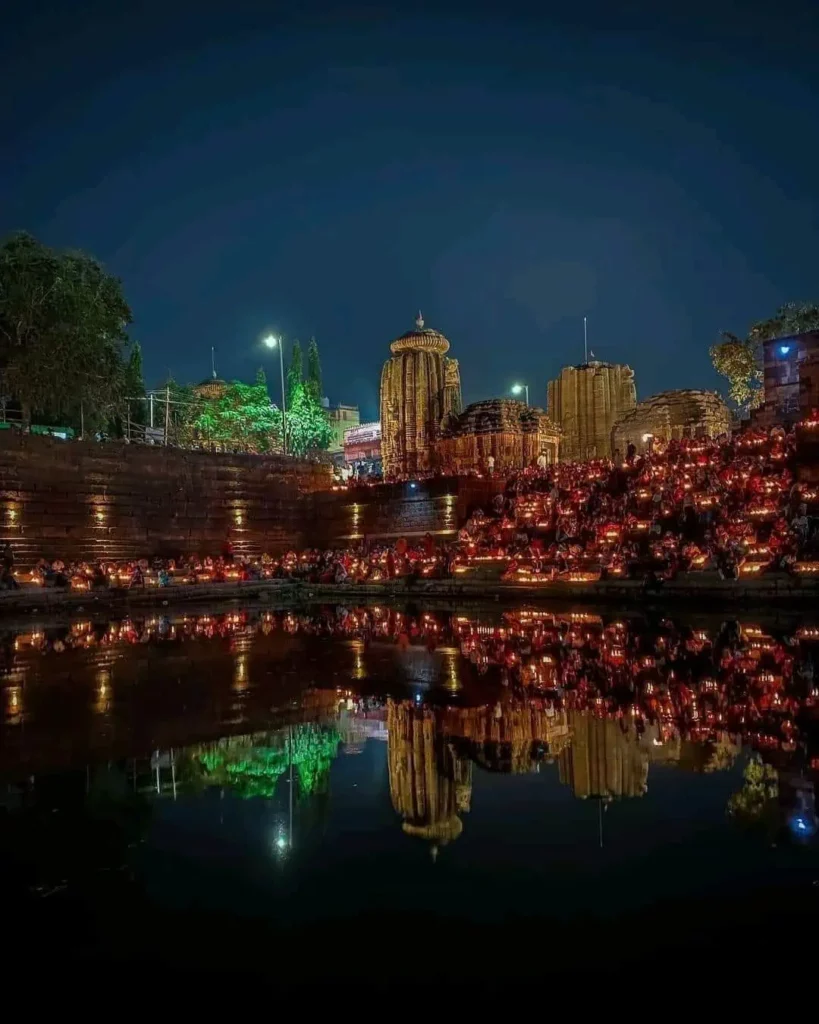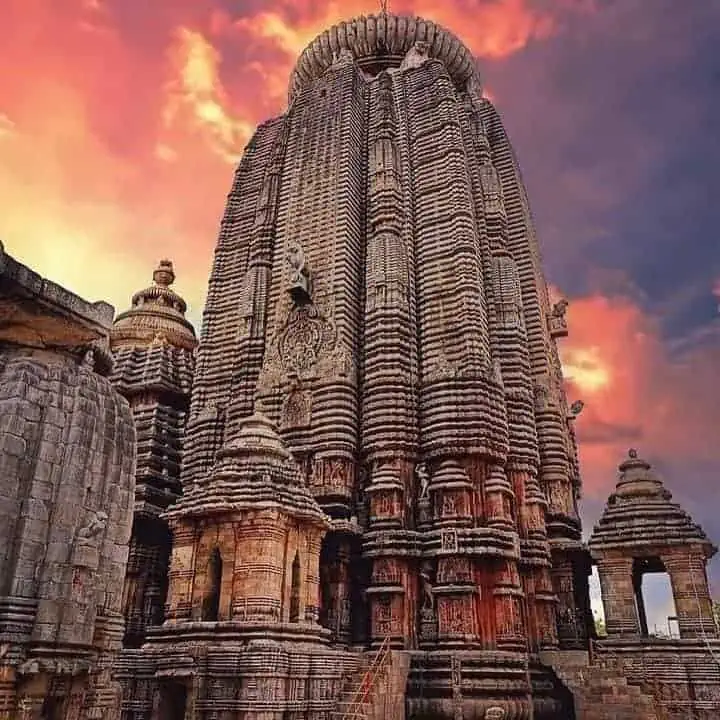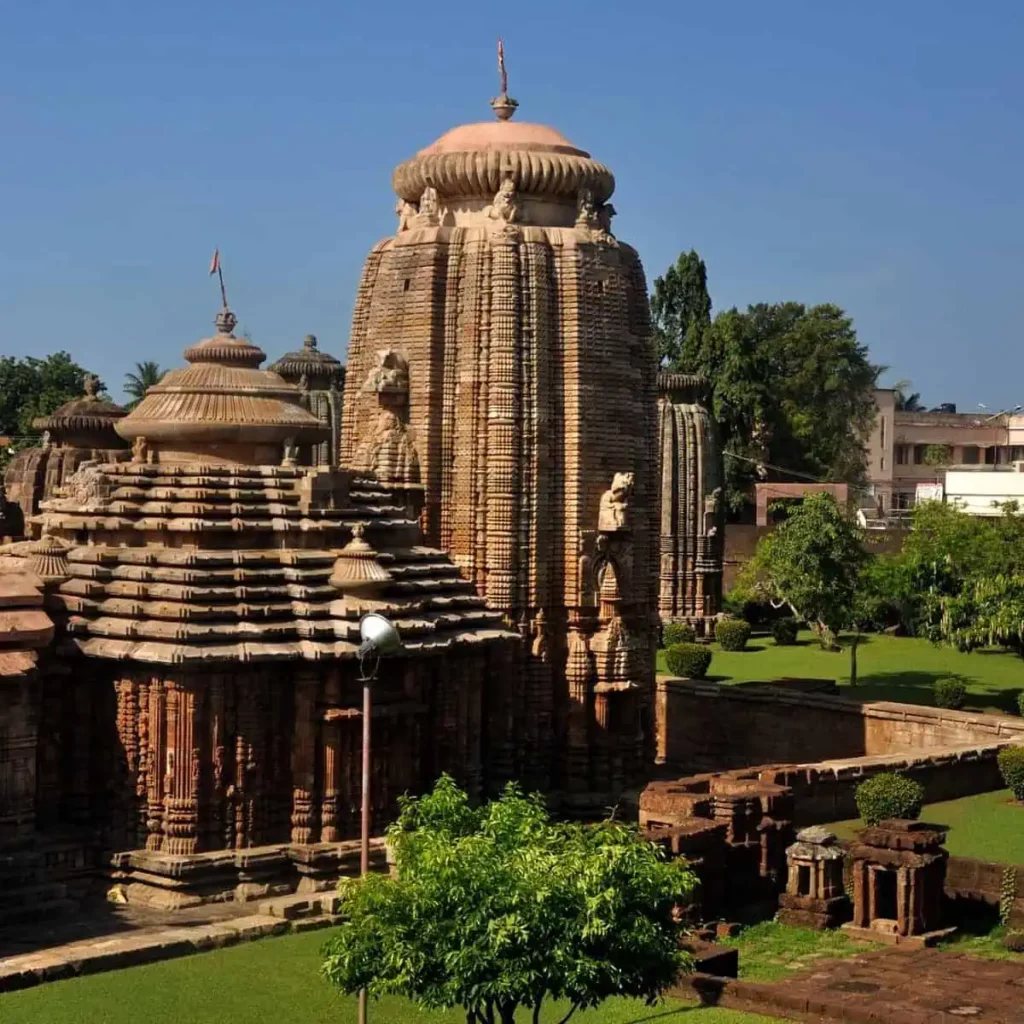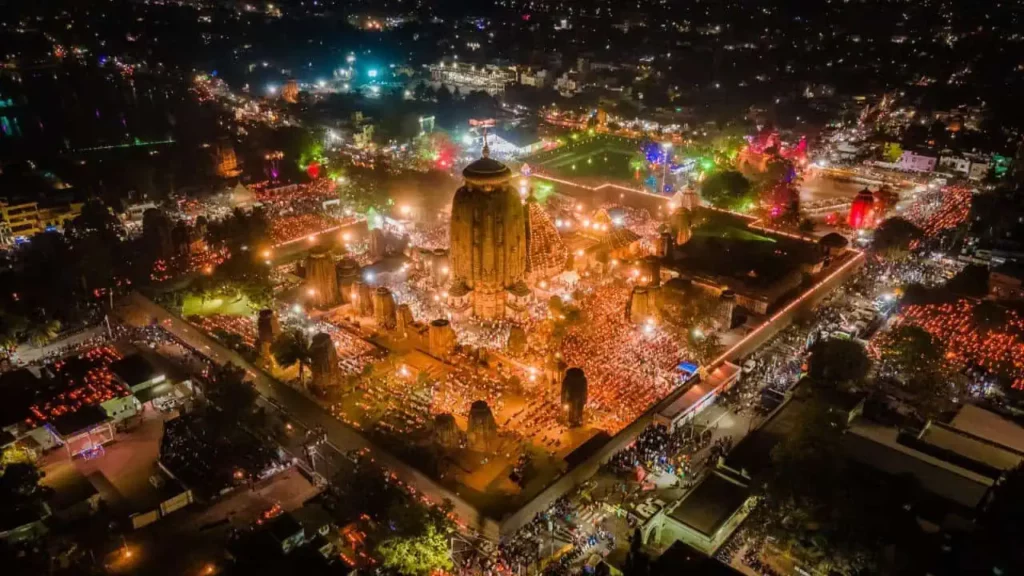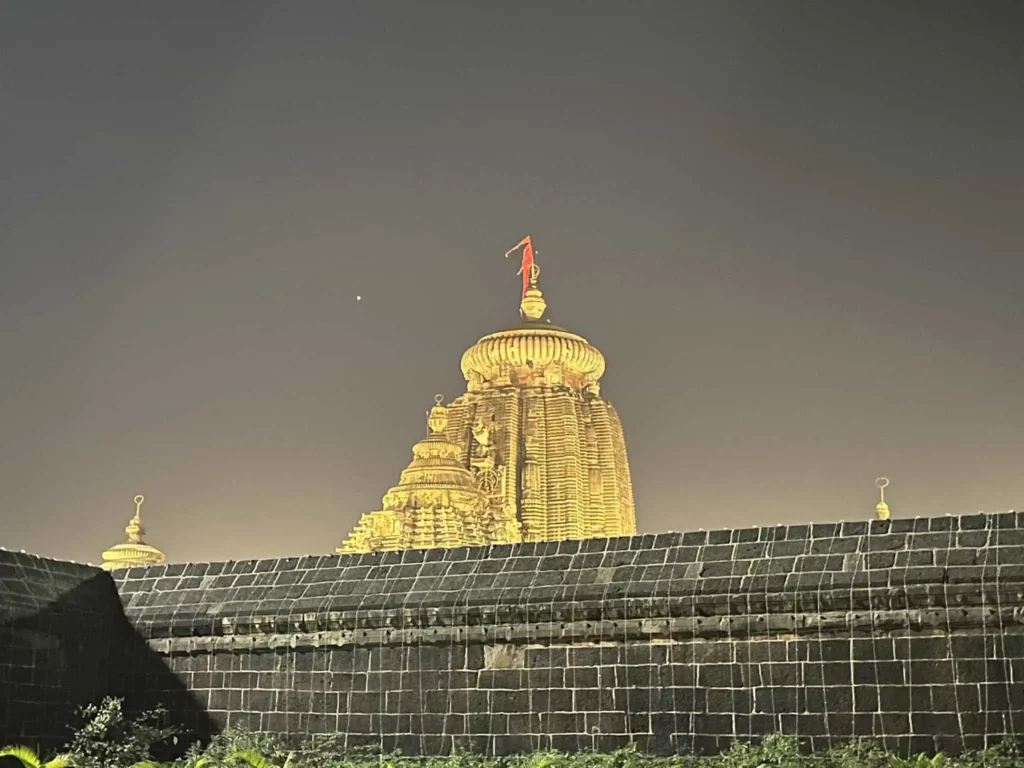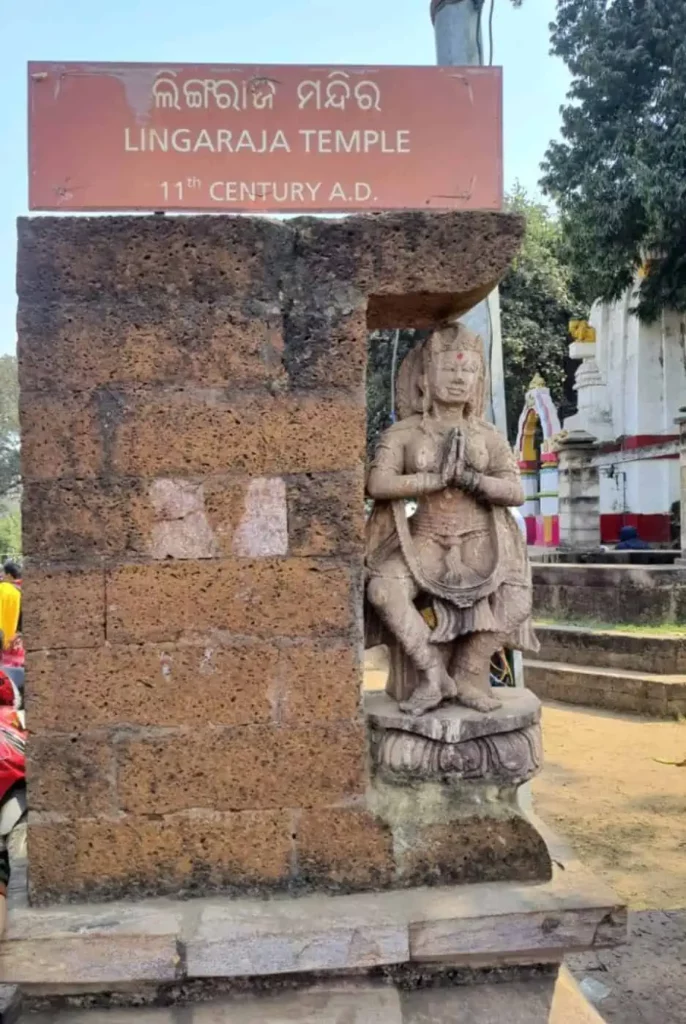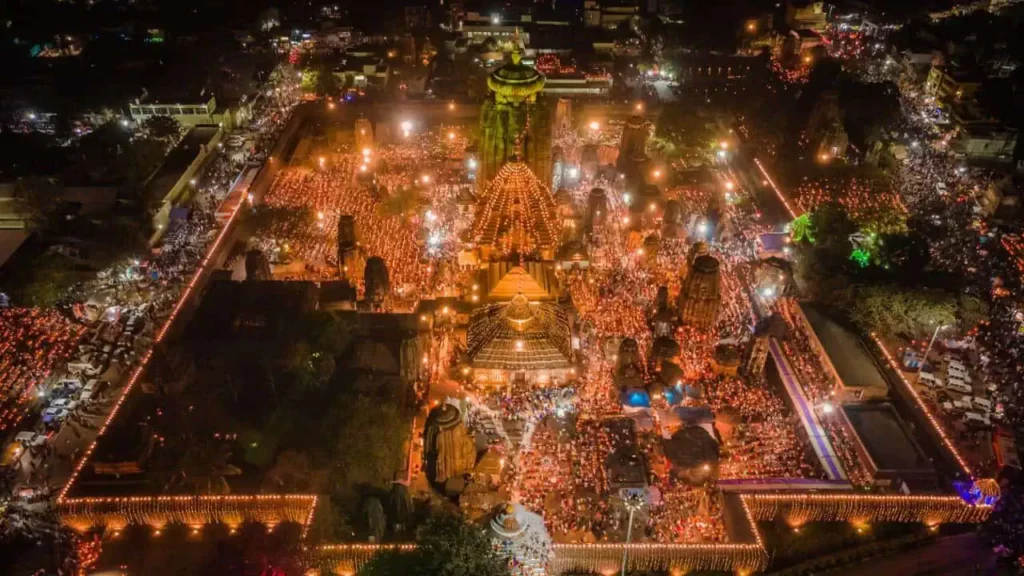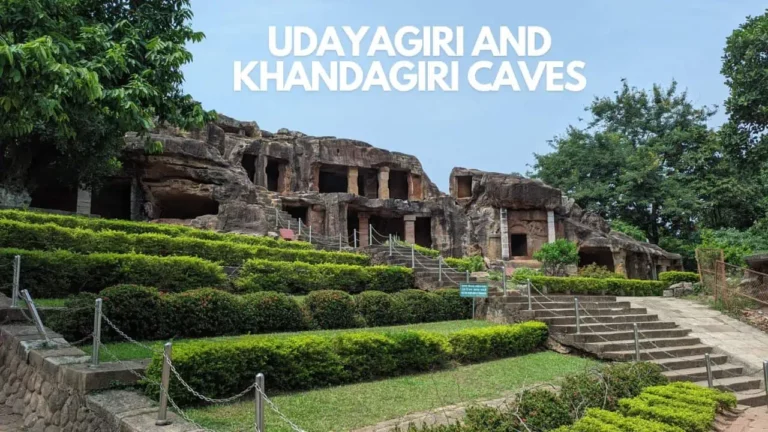Lingaraj Temple Bhubaneswar Timings, History, Architecture, Entry Fee, Prasad and Photos
The Lingaraj Temple Bhubaneswar was built in the 11th century by King Jajati Keshari of the Soma Dynasty. The temple is dedicated to Lord Shiva and is believed to be one of the oldest and largest temples in Bhubaneswar. The Lingaraj Temple in Bhubaneswar is a popular attraction that draws tourists from all over the world. This magnificent temple is an architectural marvel that showcases the rich cultural heritage of Odisha.
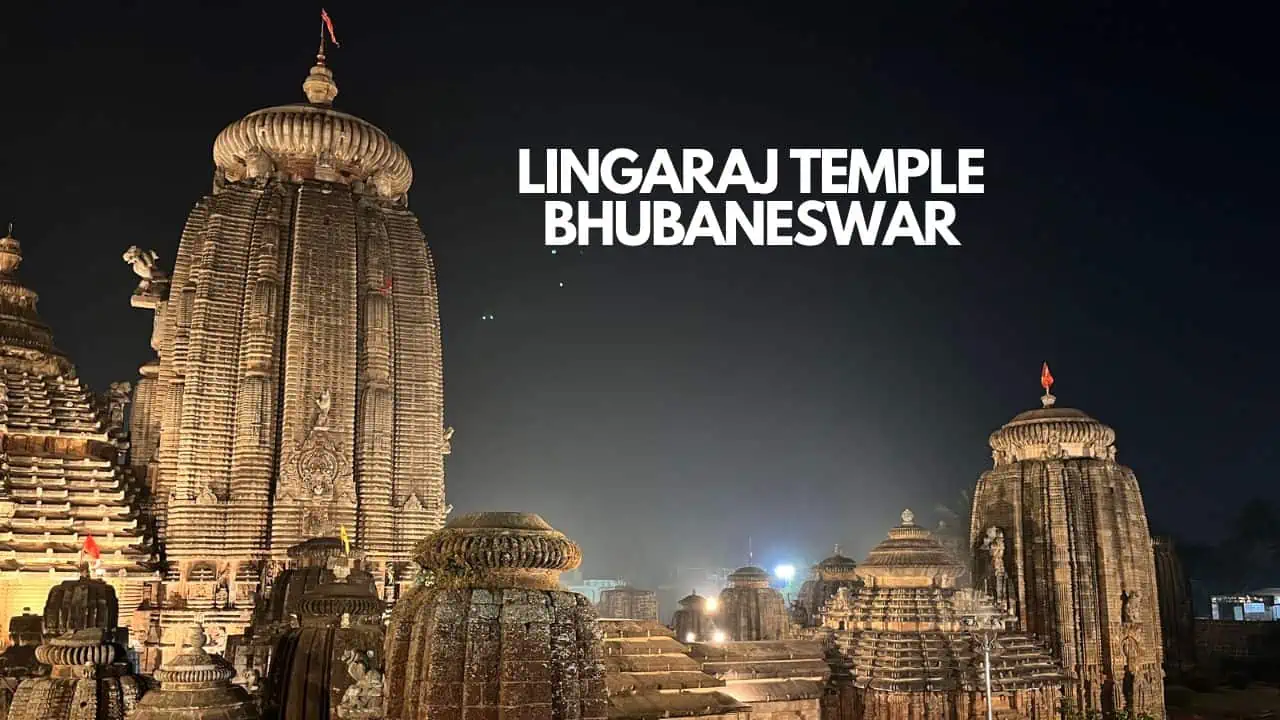
In this article, we will provide you with a comprehensive guide to Lingaraj Temple Bhubaneswar, including details on the history, architecture, timings, and entry fee.
Consider reading: History of Odisha
Lingaraj Temple Bhubaneswar Timings and Entry Fee
| Day | Timing |
|---|---|
| Monday | 6:00 am – 7:00 pm |
| Tuesday | 6:00 am – 7:00 pm |
| Wednesday | 6:00 am – 7:00 pm |
| Thursday | 6:00 am – 7:00 pm |
| Friday | 6:00 am – 7:00 pm |
| Saturday | 6:00 am – 7:00 pm |
| Sunday | 6:00 am – 7:00 pm |
Some advice for your visit to Lingaraj Temple:
- Only Hindus are permitted to enter the temple premises.
- A platform is available for non-Hindus to view the temple from the outside.
- Electronic gadgets and cameras are strictly prohibited inside the temple.
- Parking facilities are available outside the temple premises.
- Footwear is not allowed inside the main temple.
- It is recommended to avoid strangers offering “Puja” services, and instead, approach the temple priests for such services.
The History of Lingaraj Temple Bhubaneswar
The Lingaraj Temple Bhubaneswar was built in the 11th century by King Jajati Keshari, who was a devotee of Lord Shiva. The temple was initially a small shrine that housed a simple Lingam. However, over the years, it grew in size and grandeur as various rulers and dynasties made their own additions and renovations.
The Lingaraj Temple, an emblematic landmark, embodies the rich legacy of various dynasties that ruled the region, each leaving an indelible mark on its architecture and cultural heritage. This temple has evolved over centuries, reflecting the artistic and religious fervor of the times.
Chronicles of Architectural Evolution:
- Ganga Dynasty’s Contributions (12th – 15th Century): This era saw the addition of numerous temples and shrines, each adorned with detailed carvings and sculptures, enriching the temple complex.
- Renovation under King Kapilendra Deva (16th Century): The ‘Bhoga Mandapa’, a dining hall for temple rituals, was introduced, adding another layer to the temple’s architectural splendor.
- Maratha Influence (18th Century): The Maratha rule was marked by further enhancements, including the ‘Mukti Mandapa’, augmenting the temple’s spiritual and architectural grandeur.
Spiritual and Cultural Significance:
- Connection to the Mahabharata: The temple’s origin is linked to a divine vision received by King Jajati Keshari, adding a mythological dimension to its history.
- Lingaraj Rath Yatra: This annual festival is a vibrant celebration, drawing devotees from across the globe, emphasizing the temple’s religious importance.
A Pilgrimage and Cultural Hub:
- Annually, the temple beckons millions of Hindu devotees, offering a spiritual haven.
- The temple complex, sprawling over a vast area, encompasses smaller temples, shrines, sacred water bodies, and wells, each integral to the devotees’ rituals.
Architectural Marvel in Kalinga Style:
- The Lingaraj Temple stands as a testament to the Kalinga style of architecture, renowned for its intricate carvings and unique design elements.
The Lingaraj Temple, therefore, is more than a religious site; it is a living museum of history, culture, and architectural brilliance, encapsulating the essence of the region’s heritage.
Lingaraj Temple Bhubaneswar Architecture
The Lingaraj Temple in Bhubaneswar stands as a majestic embodiment of Kalinga-style architecture, a style renowned for its pyramid-shaped roofs, elaborate carvings, and detailed sculptures. Crafted from red sandstone, this temple is a canvas displaying the rich tapestry of Hindu mythology and deities.
Architectural Highlights:
- Kalinga-Style Design: Characterized by its distinct pyramid-shaped roof, the temple is a classic representation of this architectural style.
- Red Sandstone Construction: The use of red sandstone adds a unique warmth and grandeur to the temple’s appearance.
Entrance and Main Hall:
- Torana – The Main Entrance: This grand entrance is a marvel in itself, adorned with intricate carvings and sculptures of various Hindu deities, leading devotees into the main hall.
- Main Hall for Devotion: The hall is a spiritual sanctuary where devotees offer prayers to Lord Shiva, the primary deity of the temple.
Smaller Shrines Within the Complex:
- The complex houses multiple smaller shrines dedicated to different Hindu deities, each adorned with exquisite carvings and sculptures, echoing the main temple’s artistic brilliance.
Exquisite Artwork:
- Intricate Carvings: The temple’s walls are etched with detailed carvings depicting gods, goddesses, and scenes from Hindu mythology, bringing the stone to life.
- Sculptures of Hindu Deities: These sculptures stand as some of the finest examples of Hindu art, each crafted meticulously, showcasing the artisans’ unparalleled skill.
The Lingaraj Temple is not just a religious site but a testament to the artistic and architectural prowess of ancient India. Its intricate carvings and sculptures make it a significant cultural landmark, attracting not only devotees but also admirers of art and history.
Lingaraj Temple Bhubaneswar Images
How to reach Lingaraj Temple Bhubaneswar
The Lingaraj Temple, a renowned spiritual and cultural site, is strategically situated in the heart of Bhubaneswar, offering easy accessibility from various city locations. This central location ensures a smooth and hassle-free visit for travelers and pilgrims alike.
Effortless Connectivity:
- Diverse Transportation Options: The city’s extensive transport network includes auto-rickshaws, local buses, and private taxis, ensuring convenient travel to the temple.
- Close Proximity to Major Transport Hubs:
- Biju Patnaik International Airport: Just 4.4 km away, a quick 15-20 minute ride by auto-rickshaw or taxi.
- Bhubaneswar Railway Station: Located around 4.8 km from the temple, reachable in about 15-20 minutes by auto-rickshaw or taxi.
The central location of the Lingaraj Temple in Bhubaneswar simplifies travel logistics, allowing visitors to focus on the spiritual and cultural experience awaiting them at this revered site.
Lingaraj Temple Bhubaneswar Google map link – Click Here
Things to do at Lingaraj Temple Bhubaneswar
Visiting the Lingaraj Temple in Bhubaneswar is not just about offering prayers; it’s an opportunity to immerse oneself in the rich tapestry of religious and cultural landmarks that surround this sacred site. Here are some notable attractions to enhance your spiritual journey:
- Bindu Sarovar: A Sacred Lake with Historical Significance
- Located north of the Lingaraj Temple, this expansive lake spans 700 feet in width and 1300 feet in length.
- It is the center stage for the annual Chandan Yatra festival, a significant event in the Hindu calendar.
- Ekamra Van: A Garden Steeped in Mythology
- Situated west of Bindu Sarovar, Ekamra Van, or “a forest of a single mango tree,” is a serene garden.
- As per Hindu mythology, Bhubaneswar was known as Ekamra Van in ancient times.
- The garden is home to various plants, each associated with different Hindu deities and known for their medicinal properties.
These nearby attractions offer a deeper insight into the religious and cultural heritage of Bhubaneswar, making a visit to the Lingaraj Temple a more holistic and enriching experience.
Consider reading: Top 11 Best Places to visit in Bhubaneswar
Lingaraj Temple Bhubaneswar Prasad
At the heart of the Lingaraj Temple experience is the distribution of Prasad, a consecrated offering that holds immense spiritual significance for the devotees of Lord Shiva. This sacred tradition is an integral part of the temple visit, deeply revered by pilgrims.
Significance and Belief:
- Blessings of Lord Shiva: Consuming the Prasad is believed to bestow Lord Shiva’s blessings, fulfilling wishes and desires.
- Healing Properties: The Prasad is also thought to possess healing powers, offering relief from various physical and mental ailments.
Composition and Preparation:
- Variety of Offerings: The Prasad includes a mix of sweets, fruits, and other food items, each prepared with the utmost care and devotion.
- Hygienic Preparation: Ensuring cleanliness and purity, the Prasad is prepared in a hygienic environment, starting early in the morning.
- Quality Ingredients: Only the best quality ingredients are used, aligning with the sanctity of the offering.
- Blessed by Priests: Before distribution, the Prasad is blessed by the temple priests, imbuing it with spiritual significance.
Distribution to Devotees:
- Post-Puja Offering: Following the completion of the daily puja, the Prasad is distributed to the devotees by the temple priests.
- Consumption and Takeaway: Devotees can consume the Prasad within the temple premises or take it home as a sacred blessing from the deity.
The Prasad at Lingaraj Temple is not just a food offering; it’s a symbol of devotion and a tangible connection to the divine, deeply cherished by those who visit this revered site.
Popular Festivals Celebrated at Lingaraj Temple Bhubaneswar
Here are some of the popular festivals celebrated at Lingaraj Temple:
The Lingaraj Temple in Bhubaneswar is not just a revered shrine but also a vibrant center of cultural and religious festivities. Throughout the year, the temple hosts several festivals that attract devotees and tourists alike, each festival bringing its own unique charm and significance.
1. Mahashivratri: A Revered Celebration of Lord Shiva
- Celebrated in February or March, Mahashivratri marks one of the most important festivals for Lord Shiva’s followers.
- Devotees from across the country flock to the temple to offer prayers and partake in the spiritual ambiance.
2. Ratha Yatra: The Chariot Festival
- This annual chariot festival sees the deities of Lord Lingaraj, Lord Rukmini, and Lord Radha being taken on a procession through Bhubaneswar’s streets.
- The beautifully decorated chariots and the grand procession are a spectacular sight, drawing thousands of onlookers.
3. Durga Puja: Honoring Goddess Durga
- Celebrated in September or October, Durga Puja pays homage to Goddess Durga, the embodiment of divine female power.
- The temple is festooned with lights and flowers, creating a festive atmosphere for devotees offering prayers and seeking blessings.
4. Janmashtami: Celebrating Lord Krishna’s Birth
- Janmashtami, marking Lord Krishna’s birthday, is observed with great enthusiasm.
- The temple is adorned for the occasion, and devotees engage in bhajans and special prayers.
5. Shivratri Fair: A Five-Day Cultural Extravaganza
- Coinciding with Mahashivratri, this fair transforms the temple premises into a bustling marketplace with various stalls and cultural events.
- The fair, lasting five days, offers an array of activities and entertainment options for visitors.
Each festival at Lingaraj Temple offers a unique glimpse into the rich tapestry of Indian spirituality and cultural heritage, making the temple a focal point for those seeking a profound religious and cultural experience.
FAQs on Lingaraj Temple Bhubaneswar
What is the best time to visit Lingaraj Temple?
The best time to visit Lingaraj Temple is between October to March, as the weather during this period is pleasant and ideal for sightseeing. However, if you want to witness the festivals celebrated at the temple, you can plan your visit accordingly.
What is the dress code for visiting Lingaraj Temple?
Visitors are advised to dress modestly and conservatively while visiting Lingaraj Temple. Shorts, skirts, and sleeveless tops are not allowed inside the temple premises.
Is photography allowed inside the temple?
Photography is strictly prohibited inside the temple premises. Visitors are not allowed to take pictures of the deities or the temple’s interior.
What is the significance of the Lingaraj Temple?
Lingaraj Temple is considered to be one of the most important Shiva temples in India. It is believed to be a sacred site where Lord Shiva is worshipped in his lingam form. The temple is also a major tourist attraction and a symbol of the rich cultural heritage of Odisha.
